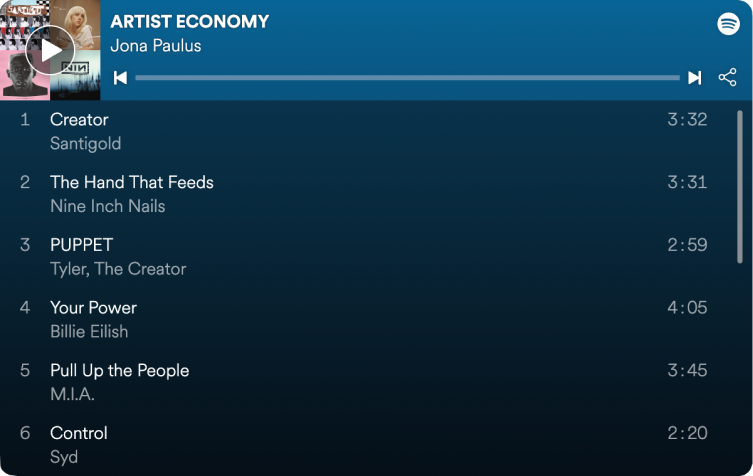Artist Economy & Crypto
👽💎 Why can Ed Sheeran make $6.5M per song, when Wet Leg can only make $40K? 💎 Smesher #010
It’s easy to agree with this saying by Picasso 👆 especially when you watch kids drawing or dancing. They often display such freedom, unburdened by knowledge and self-consciousness. Most grownups need to work hard to regain that freedom.
But there is another problem facing adults who want to remain artists: Making a living.
Food for thought: An artist living in market-priced housing in New York City, will have four hours of art-making a week. Whereas an artist living in a community-land-trust will have twenty-seven hours. (Full article by Natalia Linares and Caroline Woolard). We’re guessing the other twenty-three hours go towards earning a living.
Why must artists be poor?
This is the title of Hadi Eldebek’s humorously delivered yet slightly depressing TED talk. Eldebek — a musician and activist-entrepreneur for the arts — shares a few statistics about the artist economy in the United States:
“The US budget for National Endowment for the Arts (…) is a mere $146M (…) whereas the US budget for the military marching bands alone is almost twice that.”
The military marching bands? Really?
Here’s another thought:
US military spending in 2021 was $705 billion. For just 0.5% of that, we could grant 58,750 artists $5K a month for a year!
Some people, even art lovers, might ask ‘why should we give money away to artists?’ These people might be surprised to learn that artists are no free riders: in 2015, the nonprofit arts industry alone generated $27.5 billion in revenue for local, state, and federal governments. (Full story here). So why should an industry generating $27.5 billion in taxes, get less than 1 billion in funding?
But it’s not just the government’s fault
As of the first quarter of 2022, Spotify had 182 million premium subscribers worldwide. This probably includes some of us. Let’s assume an average premium price of $10 a month. That’s one billion eight hundred twenty million dollars a month. Not too shabby. For Spotify that is.
Because the artists get only a fraction of this. $.0033-$.0054 per stream, to be percise. “Meaning a song would have to be streamed three times for an artist to make a penny.״
Not everyone makes pennies though. Drake — Spotify’s highest earner — earned an estimated $52,546,150.
Ed Sheeran made $6,566,000 just for Shape of You. Don’t get us wrong, we love the song.
Spotify claims its Discovery feature benifits artists. In 2016 the company reported that Discover Weekly reached 40 million users and 5 billion tracks streamed. "I think we are really onto something in terms of democratizing the overall discovery process," their Chief Content and Strategy Officer, Stefan Blom, said to billboard back then.
And he was probably right as far as discovery goes. But can discovery be monetized?
The answer is no, not on Spotify anyway, with 1% of artists accounting for nearly 80% of streams, and the top 10% for 98% of the streams.
A long tail’s tale
In 2018 Spotify launched Spotify for Artists, letting independent musicians upload their work to the platform. And if you’ll ask the company’s execs, they’ll likely claim that they are serving the music community, by utilizing top artists, to bring listeners who then discover the long tail of less known artists.
We claim, it is the other way around.
Listeners come to Spotify to discover artists they don’t know. If they only wanted to listen to the top 1%, they could have continued buying albums.
So it is the long tail of lesser known artists that is the break or make of Spotify.
And yet, those artists can’t make a living out of it. Not even close. And it is the same for content creators on all other web 2.0 platforms, from YouTube, to Facebook etc. ״Predatory revenue models like programmatic advertising and data tracking, combined with the high cost of data to serve mobile ads, prevent millions from participating in digital creator economies.”
How can crypto help?
In this issue of Smesher, it’s easier than ever to answer our recurring question: How can crypto help?
“Using an open payments network in which anyone can seamlessly earn, buy, sell, trade and share,” seems like an obvious solution. And it’s what the Interledger Foundation is striving to achieve. “An open and inclusive payments network that puts humanity first.”
Now imagine a Spotify-like platform, where money paid by listeners, is instantly and equitably split between all relevant parties.
And this W3C model can be applied not only to music, but to film, literature and any other creator industry too. Cinnamon for example, are already using Coil — a web monitization providor — to let content creators get paid 4 times per second. Not once every 10 days like you-know-who.
Coil themselves have developed a very interesting model, that supprts online creators by enabling monetization of theie web content.
So if you are an artist, an art lover or a developer, consider all these options of moving from the old and unfair models, towards new models that will enable us to continue making and enjoying art. Click here to listen to the Artist Economy inspired playlist we made for you. For now, on Spotify.







